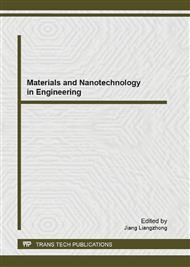[1]
J. Davidovits. Synthesis of New High-Temperature Geo-Polymers for Reinforced Plastics/Composites: SPE PACTFC 79, Society of Plastic Engineers, Brookfield Center, USA, 1979, p.151–154.
Google Scholar
[2]
R. Feret. Slags for the manufacture of cement: Rev Mater ConstrTrav Publish, July, 1939.
Google Scholar
[3]
Fernandez-Jimenez A, Palomo A (2005). Composition and Microstructure of Alkali Activated Fly Ash Binder: Effect of the Activator. Cem. Concrete Res., 35: 1984-1992.
DOI: 10.1016/j.cemconres.2005.03.003
Google Scholar
[4]
Glukhovsky, V. D, "Soil Silicates", Gosstroi Publishers, Kiev, Ukraine, 1959.
Google Scholar
[5]
Hu M, Zhu X, Long F (2009). Alkali-activated fly ash-based geopolymers with zeolite or bentonite as additives. J. Cem. Concrete Composit., 31: 762-768.
DOI: 10.1016/j.cemconcomp.2009.07.006
Google Scholar
[6]
Panias, D., Giannopoulou, I., Perraki, T. (2007), "Effect of synthesis parameters on the mechanical properties of fly ash-based geopolymers", Colloids and Surfaces A: Physicochemical and Engineering Aspects, Volume 301, issue 1-3 pp.246-254.
DOI: 10.1016/j.colsurfa.2006.12.064
Google Scholar
[7]
D.M. Roy. Alkali-activated cements: Opportunities and challenges: Cement and Concrete Research, Vol.29(2), 1999, pp.249-254
DOI: 10.1016/s0008-8846(98)00093-3
Google Scholar
[8]
Sumajouw, D. M. J., Hardjito, D., Wallah, S. E., Rangan, B. V., "Fly ash-based geopolymer concrete: study of slender reinforced columns", Journal of Materials Science, V. 42, 2007, p.3124 – 3130.
DOI: 10.1007/s10853-006-0523-8
Google Scholar
[9]
Temuujin, J., Van Riessen, A., and Williams, R., "Influence of calcium compounds on the mechanical properties of fly ash geopolymer paste", Journal of Hazardous Materials, 2009.
DOI: 10.1016/j.jhazmat.2008.12.121
Google Scholar
[10]
Yang, K. H., Song, J. K., Ashour, A. F., Lee, E. T.(2008), "Properties of cementless mortars activated by sodium silicate", Construction and Building Materials, Vol. 22, Issue 9, p.1981–1989.
DOI: 10.1016/j.conbuildmat.2007.07.003
Google Scholar


